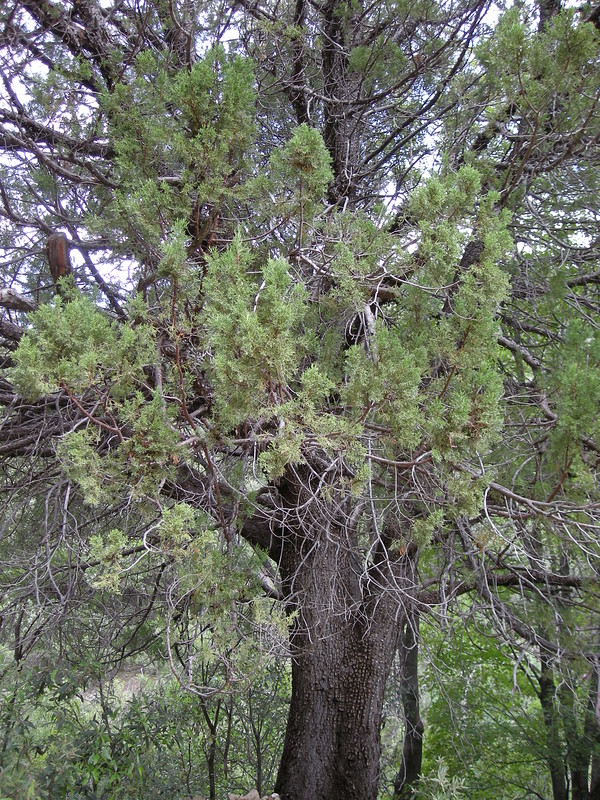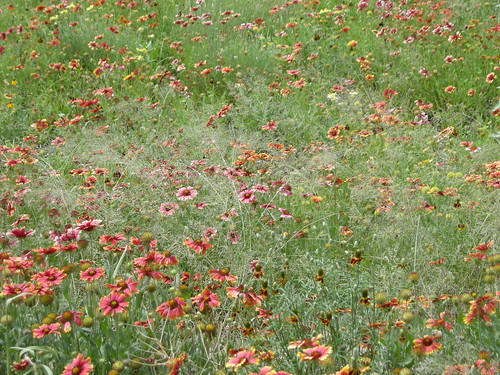 |
| Photo: Mine |
 |
| Credit: Forestryimages.org Thumb sized PT Mycorhizae Truffle associated with young Slash Pines |
 |
| Photo Mine |
This little tree was planted in 1996. It never struggled, but did get nibbled on by rabbits until I put the chicken wire around it. Babied it the first your with regular weekly water and tapered off with monthly. After that first year I did nothing. As you can see, it is now about one meter high as of June 2013. Also, notice I put it smack in the middle of old growth Redshank or Ribbonwood (Adenostoma sparsifolium) Chaparral High Desert Elfin Forest. I
never do give it another thought to remove what many people usually consider evil competition. I also contacted Dr Donald Marx (PHC Chief Scientist) in Frogmore South Carolina when I discovered that the colonization actually took. He was blown away too. So was I. So I sent him some pics. It's amazing how much there is yet to be discovered, especially in such an arrogant world where the leadership believes it knows it all. Eventually when the root system reaches a maximum point of establishment and the top of the Juniper pushes through the Chaparral tree canopy, it'll really take off. In the mean time, the environmental conditions will allow very few lower tree branches and being supported in early life by the chaparral will have a nice clean trunk for which that characteristic Alligator bark will manifest itself beautifully.
 |
| Photo: Mine |
 |
| Photo: Mine |
 |
| Photo: Mine |
Some interesting fire ecology facts about Alligator Juniper. While like most other living plants this tree will burn, but it also has the amazing ability to sprout back from it's root system. It's rugged reptilian looking bark is tough enough to withstand fire and has been noted that most canopies and crowns of Alligator Juniper are untouched, although lower limbs may be scorched. The foliage example as referenced in the picture above reveals just how beautiful this tree could be for the landscape and especially in areas where there are water issues.
There were other trees and plants worthy of note in the Huachucas. Apache Pine (Pinus engelmannii) is another one of those interesting pines that doesn't fit the profile of pines in So-Cal. It has a brighter green foliage which is itself much like those long subtropical needles pines. When it is a young sapling, it is often referred to as the "Hippie Pine". I acquired one years before my Alligator Juniper find, from a Native Plant Nursery in Elgin Arizona just south of Sonoita. The Nursery was owned by James (Jim) Koweek of Elgin and he later moved his Diamond JK Nursery to Sonoita Arizona just to the north at the Junctions of Hwy 82 & Hwy 83. He has since sold it and now has a Soil Preparation Services company and website here: http://www.azreveg.com/
 |
| Photo: Mine |
This particular Apache Pine was up that same Carr Canyon Rd. I planted one of these Apache Pines on my Anza property in the early 1990s. After I sold that property in 2002, in 2003 it was rented out by the new owner to a guy who was a tree trimmer. He had lots of equipment and wanted a place for parking it. Understandable since Anza is known for having plenty of citizens with sticky finger tendencies. But he leveled half a dozen fairly large pines to do this along with Chaparral and the Apache and Arizona White Pines were among these. When I visited a few years later and discovered the loss, it was similar to my shock with the Rattlesnake Mountain Torrey Pine removal. Oh well, it was no longer my place anyway. But that Apache pine was almost 10 foot tall with good branch density when I left. The foliage of course stood out with it's bright green (almost Ponderosa looking) and did also prove that such pines would do well there. For all you off the hill plant shoppers, get a clue.
 |
| Photo: Mine |
Just by way of location and height reference for the former Apache Pine on my property as of 2002. This photo above is a fortunate Coulter Pine that was not touched by the tree trimmers Ax or Chainsaw. You can see the height and branch circumference here are very very healthy. The Apache Pine was on the other side of this photo angle to the north and this tree was only one and a half foot tall compared to the 10 foot tall Apache when I left. So the Apache would have been more than doubled in it's size today if still alive. Also keep in mind as far as growth and health issues go, none of these trees on my former property are watered and have even endured the low rainfall years (eleven or twelve) since 2001 until this present day. So they still haven't done too bad. Shows what a healthy mycorrhizal grid network will do for a landscape system.
And Finally -
 |
| Photo: Mine |
 |
| Photo: Mine |
 |
| Photo: Mine |
These last three pictures are of the meadows of grasses and flowers leaving Ramsey Canyon back toward Hwy 91 South. Keep in mind the best time of year to visit is July/August when the summer Monsoons are in full force. Sad to say, from the climate shifting News Reports I am hearing, there may be an abnormal shift from July/August to September/October. This may well screw up many things with regards several ecosystems in the southwest.
~~~~~~~~~~~~~~~~~~~~~~~~~~~~~~~
Good Reading References:
U.S. Forest Service & Alligator Jumiper Fire Ecology








